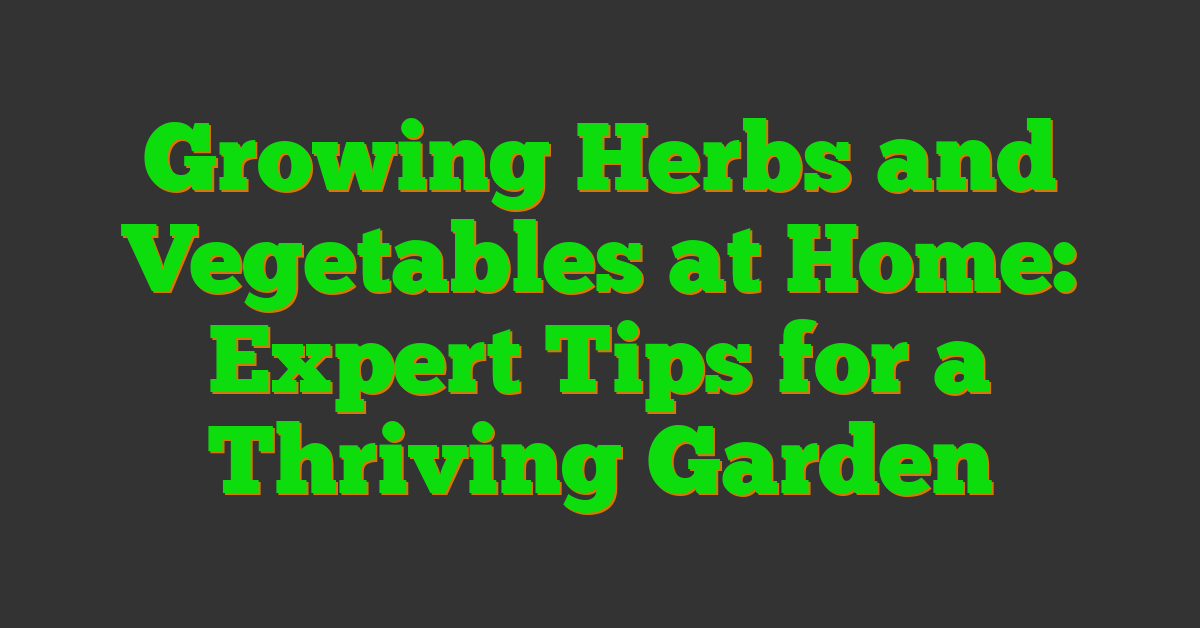There’s something incredibly satisfying about plucking fresh herbs and vegetables straight from your own garden. Whether you have a sprawling backyard or just a cozy balcony, growing your own food is more accessible than ever.

I’ve discovered that with a bit of planning and care, anyone can cultivate a vibrant garden. From fragrant basil and mint to crisp lettuce and tomatoes, the possibilities are endless. Plus, there’s nothing quite like the taste of homegrown produce in your meals.
In this article, I’ll share my top tips and simple steps to help you start growing herbs and vegetables at home, making your gardening journey both enjoyable and rewarding.
Benefits Of Growing Herbs And Vegetables At Home
Health Advantages
Growing my own herbs and vegetables ensures access to fresh, nutrient-rich produce. Harvesting at peak ripeness maximizes vitamins and minerals, unlike some store-bought options.
Cost Savings
Cultivating a home garden reduces grocery expenses. For instance, a single herb plant can supply multiple dishes, cutting down the need to purchase expensive fresh herbs regularly.
Environmental Impact
Home gardening minimizes carbon footprint. By reducing the distance produce travels, I contribute to lower greenhouse gas emissions and less packaging waste.
Enhanced Flavor
Homegrown herbs and vegetables offer superior taste. Freshly picked basil or tomatoes deliver flavors that surpass those found in supermarkets, elevating my cooking experience.
Personal Satisfaction
Tending to a garden provides a sense of accomplishment. Watching plants grow from seeds to harvest fosters a rewarding connection with nature.
Control Over Growing Conditions
I manage the use of fertilizers and pesticides in my garden, ensuring that my produce is free from harmful chemicals. This control contributes to healthier eating habits and a safer environment.
Educational Opportunity
Gardening serves as a practical learning experience. It allows me to understand plant biology, soil health, and sustainable farming practices, enhancing my knowledge and skills.
Year-Round Access
By using techniques like container gardening and indoor grow lights, I can cultivate herbs and vegetables throughout the year. This continuous supply supports a consistent and diverse diet.
Space Efficiency
Even with limited space, I can grow a variety of plants using vertical gardening or compact containers. This adaptability makes gardening feasible in apartments and small homes.
Community and Sharing
Growing my own produce enables me to share fresh herbs and vegetables with neighbors and friends. This fosters community connections and promotes a culture of sustainability.
Planning Your Home Garden
Planning sets the stage for a thriving home garden. It helps ensure your herbs and vegetables grow successfully.
Selecting The Right Location
I choose a spot with at least six hours of sunlight each day, crucial for most herbs and vegetables. I check the soil for good drainage and nutrient content. If space is limited, I use containers on balconies or patios. I also ensure the area is near a water source for easy watering.
Choosing Suitable Plants
I select plants that suit my climate and growing season to thrive in my environment. I focus on herbs and vegetables that I frequently use, such as basil, oregano, tomatoes, and spinach. I consider each plant’s size and growth habits to prevent overcrowding. Additionally, I pick varieties resistant to local pests and diseases to reduce maintenance.
Essential Tools And Supplies
- Gardening Tools: I use a trowel, pruning shears, and sturdy gloves for planting and maintenance.
- Containers: Selecting pots, raised beds, or vertical planters accommodates different space requirements.
- Soil and Fertilizers: High-quality potting mix and organic fertilizers ensure healthy plant growth.
- Watering Equipment: A hose with adjustable nozzles or a reliable watering can maintains consistent moisture levels.
- Lighting: Grow lights support plants in areas with limited natural sunlight.
- Support Structures: Stakes, trellises, or cages help manage vine and tall plant growth.
- Seeds or Seedlings: Choosing certified seeds or healthy seedlings kickstarts the gardening process.
- Labels: Durable plant labels track different herbs and vegetables accurately.
- pH Meter: Monitoring soil pH levels ensures optimal nutrient absorption.
Planting And Care Techniques
Proper planting and consistent care ensure your herbs and vegetables thrive. Here’s how I manage these essential tasks:
Soil Preparation
Preparing the soil sets the foundation for healthy plant growth.
- Testing Soil Quality: I use a soil test kit to measure pH levels and nutrient content, ensuring optimal conditions for each plant type.
- Amending Soil: If the pH is outside the ideal range, I adjust it by adding lime to raise pH or sulfur to lower it. Incorporating compost enhances soil fertility and structure.
- Drainage Management: I ensure containers and garden beds have proper drainage by adding perlite or coarse sand, preventing waterlogged soil and root diseases.
Watering And Fertilizing
Maintaining appropriate moisture and nutrient levels is crucial for plant health.
« Best Pruning Shears for Shrubs: Top Picks, Features & Comprehensive Buying Guide Creating a Tire Planter for Your Yard: Easy DIY Guide »
- Watering Schedule: I water my plants early in the morning, providing about one inch of water per week. I adjust the frequency based on rainfall and temperature to keep the soil consistently moist but not soggy.
- Fertilizing Routine: I apply organic fertilizers, such as compost or fish emulsion, every two weeks. These fertilizers supply essential nutrients like nitrogen, phosphorus, and potassium, promoting vigorous growth.
- Monitoring Moisture Levels: I use a moisture meter to track soil hydration, ensuring plants receive adequate water without overwatering, which can lead to root rot and nutrient leaching.
Harvesting And Maintenance Tips
Harvesting
Herbs
- Harvest basil by pinching off the top leaves every two weeks to encourage bushy growth.
- Pick cilantro leaves before flowering for the best flavor.
- Collect parsley by snipping the outer stems, allowing inner stems to continue growing.
Vegetables
- Harvest tomatoes when fully colored and slightly soft to the touch.
- Pick lettuce leaves when they reach approximately 6 inches in length.
- Collect zucchini when fruits are 6–8 inches long to ensure tenderness.
Maintenance
- Water plants consistently, keeping soil moist but not waterlogged.
- Prune regularly to remove dead or yellowing leaves and promote healthy growth.
- Monitor for pests weekly and address any issues promptly.
- Fertilize biweekly using organic fertilizers to maintain nutrient levels.
- Support climbing plants with stakes or trellises to prevent breakage.
- Rotate crops annually to reduce soil depletion and prevent pest buildup.
Conclusion
Starting my own herb and vegetable garden has been one of the most rewarding experiences I’ve had. Watching my plants thrive and knowing exactly where my food comes from brings a sense of accomplishment that’s hard to match.
If you’re thinking about giving it a try, I encourage you to take the plunge. Whether you have a spacious backyard or just a cozy balcony, there’s a gardening setup that’s perfect for you. Enjoy the process and celebrate each little victory along the way. Happy gardening!
















